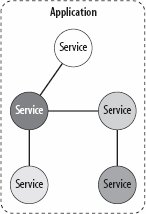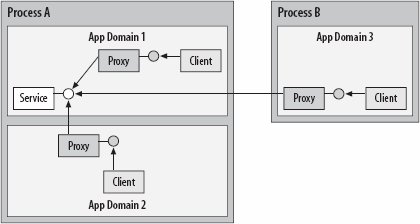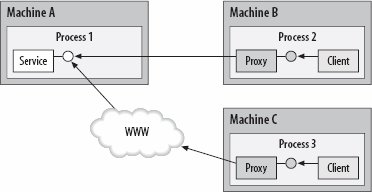Section 1.2. Services
1.2. ServicesA service is a unit of functionality exposed to the world. In that respect, it is the next evolutionary step in the long journey from functions to objects to components to services. Service-orientation (SO) is an abstract set of principles and best practices for building SO applications. If you are unfamiliar with the principles of service-orientation, Appendix A provides a concise overview and motivation for using service-orientation. The rest of this book assumes you are familiar with these principles. A service-oriented application (SOA) aggregates services into a single logical application similar to the way a component-oriented application aggregates components or an object-oriented application aggregates objects, as shown in Figure 1-1. Figure 1-1. A service-oriented application The services can be local or remote, developed by multiple parties using any technology, versioned independently, and even execute on different timelines. Inside a service, you will find concepts such as languages, technologies, platforms, versions, and frameworks, yet between services, only prescribed communication patterns are allowed. The client of a service is merely the party consuming its functionality. The client can be literally anythinga Windows Forms class, an ASP.NET page, or another service. Clients and services interact by sending and receiving messages. Messages may transfer directly from client to service or via an intermediary. With WCF, all messages are SOAP messages. Note that the messages are independent of transport protocolsunlike Web services, WCF services may communicate over a variety of transports, not just HTTP. WCF clients may interoperate with non-WCF services, and WCF services can interact with non-WCF clients. That said, typically if you develop both the client and the service, you could construct the application so that both ends require WCF to utilize WCF-specific advantages. Because the making of the service is opaque from the outside, a WCF service typically exposes metadata describing the available functionality and possible ways of communicating with the service. The metadata is published in a predefined, technology-neutral way, such as using WSDL over HTTP-GET, or an industry standard for metadata exchange. A non-WCF client can import the metadata to its native environment as native types. Similarly, a WCF client can import the metadata of a non-WCF service and consume it as native CLR classes and interfaces. 1.2.1. Services' Execution BoundariesWith WCF, the client never interacts with the service directly, even when dealing with a local, in-memory service. Instead, the client always uses a proxy to forward the call to the service. The proxy exposes the same operations as the service, plus some proxy-management methods. WCF allows the client to communicate with the service across all execution boundaries. On the same machine (see Figure 1-2), the client can consume services in the same app domain, across app domains in the same process, or across processes. Figure 1-2. Same-machine communication using WCF Across machine boundaries (Figure 1-3), the client can interact with services in its intranet or across the Internet. Figure 1-3. Cross-machine communication using WCF 1.2.1.1. WCF and location transparencyIn the past, distributed computing technologies such as DCOM or .NET Remoting aspired to provide the same programming model to the client whether the object was local or remote. In the case of a local call, the client used a direct reference, and when dealing with a remote object, the client used a proxy. The problem with this approach of trying to take the local programming model and make it the remote programming model is that there is much more to a remote call than an object with a wire. Complex issues such as life cycle management, reliability, state management, scalability, and security raised their heads, making the remote programming model significantly more complex, all because it tried to be what it is nota local object. WCF also strives to provide the client with the same programming model regardless of the location of the service. However, the WCF approach is the exact opposite: it takes the remote programming model of instantiating and using a proxy and uses it even in the most local case. Because all interactions are done via a proxy, requiring the same configuration and hosting, WCF maintains the same programming model for the local and remote cases; thus it not only enables you to switch locations without affecting the client, but also significantly simplifies the application programming model. |